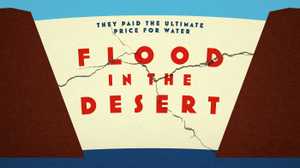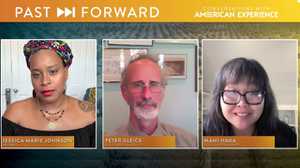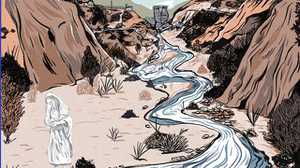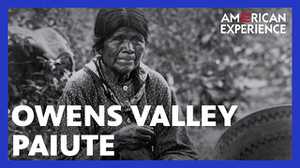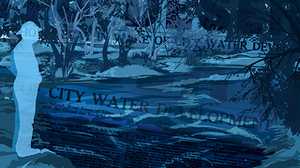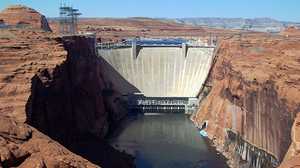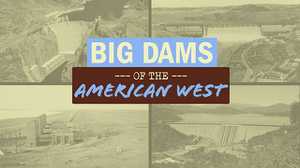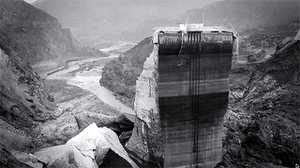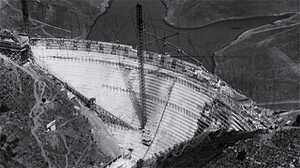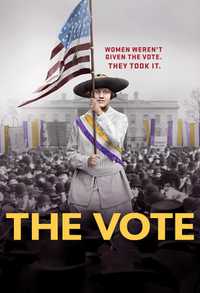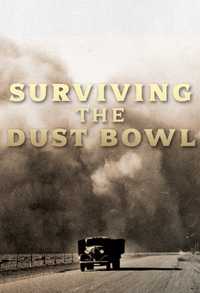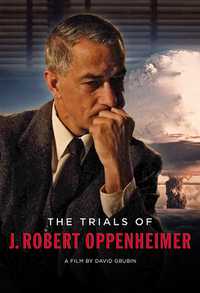Narrator: At two and a half minutes before midnight on the 12th of March 1928, the lights in Los Angeles flickered. William Mulholland was asleep at his home near Windsor Square; he didn’t notice.
William Deverell, Historian: Mulholland runs an agency that is in charge of providing water for Los Angeles. He's a civil servant. Nonetheless, he's extraordinarily powerful, and he knows it.
Erika Bsumek, Historian: Mulholland is the man who brought water to the city of Los Angeles. With the aqueduct, with the dams, he forges Los Angeles into a major city.
Narrator: Meanwhile, in a canyon forty miles northwest of the city, Ace Hopewell pulled his motorcycle to the side of the road. He passed the St Francis Dam about a mile back: Mulholland’s most recent creation, a wall of concrete twenty stories high, holding back twelve billion gallons of water. As he lit a cigarette, Hopewell heard a sound in the distance.
The St Francis Dam was collapsing.
Jon Wilkman, Writer: It’s fifty-four miles to the ocean. As many as ten thousand people are downstream from this.
J. David Rogers, Geological Engineer: They could actually feel the vibration and they could hear it coming. It felt like an earthquake.
Gloria Velasco, Descendant: They saw their neighbors running out. And then they realized. But by that time, the water was just upon them.
Louis Warren, Historian: Most of the people who were killed probably never knew what was happening to them.
William Deverell, Historian: That wall of water carried bodies out to the Pacific Ocean.
Narrator: It was one of the worst civil engineering disasters in American history, rooted in a national drive to harness Nature and remake the West.
J. David Rogers, Geological Engineer: The question is not whether water should have been brought to Los Angeles, but rather how it was done. Because the consequences are so devastating.
Erika Bsumek, Historian: When infrastructure fails, engineers use the disaster to learn from and rebuild. But the failure of the St. Francis Dam is as much a social-political story as it is an engineering story. And when there's a social disaster, we need to think about where did we go wrong as a society.
TAKE IT
José M. Alamillo, Historian: When I was a young boy my parents would always warn me not to go to the river. They would tell the story of La Llorona, a woman that would be crying along the riverbed, searching for her children. There's definitely a haunting of the river even to this day. I never understood until I was much older, why there were ghosts along the Santa Clara River.
Narrator: The St Francis Dam disaster began in a flush of hope. On a perfect November morning in 1913 forty thousand Angelenos gathered at a new landmark called the Cascades to inaugurate one of the wonders of the modern world.
Narrator: The Los Angeles Aqueduct was a perfect emblem for the city of tomorrow: more than two hundred miles of pipes and canals, carrying enough water for two-and-a-half million people - ten times the current population - from the Sierra Nevada mountains to the outskirts of the city.
Maria E. Montoya, Historian: The aqueduct does hail a new beginning for Los Angeles. It very much follows on the idea of Manifest Destiny, but now it's not just about land, it's about controlling the resources to make the American West the kind of civilization they want it to be, the kind of place that they want it to be.
Narrator: The Los Angeles Times proclaimed, “A mighty river has been brought out from the mountain wilderness, an inexhaustible supply of water.” And there was more.
Jon Wilkman, Writer: They realized that they could use this flow to turn generators and generate ninety percent of the electricity that was needed by Los Angeles.
Narrator: With ample water and clean power, L.A. would lead the way to a better future, far from the crowded cities of the East. “No black pillars of smoke shall blind the sun,” the LA Times promised, “no army of grimy workers shall feed the red-mouthed furnaces, for the river - bound with hoops of steel – shall generate the power for numberless industries.”
Erika Bsumek, Historian: We will be a modern city. We're not going to be like those older places that have these older social problems. We can remake ourselves in this new way.
William Deverell, Historian: Having quote unquote ended the frontier era, the West is now going to be won or lost, through its cities. The rise of faith in the city, it's very optimistic.
Narrator: The mastermind behind the aqueduct was the head of the Los Angeles Bureau of Water Works and Supply, an Irish immigrant who never finished grade school. “Well, I went to school in Ireland when I was a boy,” William Mulholland told a reporter, “learned the three Rs and the Ten Commandments – or most of them – made a pilgrimage to the Blarney Stone, received my father’s blessing, and here I am.”
J. David Rogers, Geological Engineer: He starts out as a ditch digger. I mean, you can't start out any lower, you know, than that. But that's what made him such a good field general. He understands the working man and how to marshal their efforts. That was what he lived for.
Flannery Burke, Historian: Angelenos really loved him because he was a working class immigrant who had made good. He was the hearty Irishman, a man of the people.
Narrator: But the settlers in the Owens River Valley, the source of LA’s water, saw William Mulholland very differently. As far as they were concerned he was taking their river, leaving farms and towns to wither on the vine. They had been kept in the dark about the aqueduct as the city quietly bought up their land and water rights.
DC Jackson, Historian: The Owens Valley was a rural, high desert community that had become settled by Euro Americans in the 1860s. Their fortunes were tied to the Owens River.
Jon Wilkman, Writer: The water wasn't stolen, but it was not acquired all in the up and up. They certainly didn't tell them that their plan really was to run the water down to Los Angeles.
Narrator: The anger in the Owens Valley would haunt Mulholland to his grave, but for most Angelenos, any qualms about the project were eclipsed by its breathtaking scale and ambition.
William Deverell, Historian: It is a gargantuan construction project: placing metal aqueduct structures in and around valleys, arroyos, sheer mountains, long, flat, dry expanses of the California landscape. It's astonishing.
DC Jackson, Historian: To think that you could bring that water over two hundred miles, that's just extraordinary at the time. It would be a huge project today.
Narrator: On that November day in 1913, when Angelenos gathered at the Cascades to celebrate the opening of the aqueduct, they were captivated by the city’s glittering future.
Shortly after 1 PM, Owens River water was released down the Cascades for the first time.
Jon Wilkman, Writer: People just rushed toward the water. They had brought tin cups to dip into the water as it was coming down, to drink the first water from this manmade river.
Narrator: As the crowd rushed to marvel at their new river, Mulholland perfectly captured the moment. “There it is,” he shouted from the stage. “Take it.”
SURPRISE, SURPRISE
J. David Rogers, Geological Engineer: The aqueduct was a game changer. It made Los Angeles the fastest growing city in the United States.
Erika Bsumek, Historian: The aqueduct teaches Los Angeles that it can do bold and amazing things.
Rachel St. John, Historian: Suburbs are springing up all over and migrants are pouring into Los Angeles. It was a moment of great excitement.
William Deverell, Historian: That's not to say this works for everybody by any stretch of the imagination. There's racial segregation in law and in practice. There's violence meted out to nonwhites. So, it's not an alchemy of fulfillment and happiness that spreads to everybody. But the mythic qualities of it are palpable. The dream was: come here, perhaps start anew.
Narrator: But as Los Angeles boomed, Southern California was drying up. By the time the population blew past the one million mark in the early 1920s, the aqueduct flow had been cut almost in half by years of drought.
J. David Rogers, Geological Engineer: Just think about it: they were looking out fifty years, and they were out of water in ten. Surprise, surprise. That’s what California is full of. It’s full of surprises.
Flannery Burke, Historian: What Mulholland created was an illusion of abundance. And so, the people of the city of Los Angeles keep using more water instead of responding to drought conditions.
Louis Warren, Historian: There are lawns everywhere. Spectacular flower gardens. The amount of water poured onto those lawns is pretty astounding.
Narrator: In order to quench L.A.’s thirst, the Bureau of Water went on another buying spree in the Owens Valley, laying claim to most of the remaining water, and further undermining the region’s economy.
Louis Warren, Historian: There's a tremendous amount of anger growing in the Owens Valley. There's a sense that the community is really being destroyed.
Rachel St. John, Historian: To see this distant city turning into a glamorous metropolis, and using their water must have been incredibly frustrating.
Erika Bsumek, Historian: Arrogance absolutely plays a big role. There is a lot of resentment that is driven by the decisions and the attitudes of people like Mulholland.
Flannery Burke, Historian: The farmers in the Owens River Valley weren't perceived as equal citizens; they are imperial subjects.
Narrator: The anger only deepened when it became clear that much of the Owens River water wasn’t going to Los Angeles at all. Even as the rest of Southern California was drying up, the city was providing vast amounts of water to farms and orchards in the San Fernando Valley, which belonged in large part to a syndicate of the most powerful men in the city.
Louis Warren, Historian: Did the city really need to provide landowners in the San Fernando Valley with that much water? Well, it turns out that the owner of the Los Angeles Times and some other associates have bought a lot of land there. Those wealthy landowners made a killing.
Maria E. Montoya, Historian: It's very easy to picture Mulholland as corrupt, but he wasn't doing this because he was getting paid off to do it or he was making money off of it. I think for him, it's really about his own vision and his power and his ability to remake nature. I think that's what's driving him.
Narrator: The threat of shortages accelerated the next phase in Mulholland’s master plan.
Louis Warren, Historian: In a dry year, if there isn't a lot of snow in the Sierra Nevada, the aqueduct won't deliver as much water to Los Angeles. So they need storage, a big reservoir, so you could fill it up in the wet years and in the dry years, it'll tide you over.
J. David Rogers, Geological Engineer: In the summer of 1922, Mulholland decided to build seven new dams near the southern end of the aqueduct, including a pair of majestic concrete structures worthy of a great metropolis: the Hollywood Dam in the hills overlooking Los Angeles, and biggest of all, the St. Francis Dam, in a canyon forty miles northwest of the city.
Rachel St. John, Historian: The St. Francis Dam and the Hollywood Dam are similar structures; they were both built with the same design, a tribute to engineering triumph and the control of nature, and it's impossible not to think that he saw it as a tribute to him as well.
Narrator: Plans were drawn up in Mulholland’s offices in the fall of 1922. Twenty years before, the city had required that a group of experts review his plans for the aqueduct. But that was then.
Dc Jackson, Historian: This is that sense that he had earned the right to sort of do what he wanted to do.
J. David Rogers, Geological Engineer: This is the second largest storage reservoir in Southern California. It should have had peer review, at least some people outside his organization reviewing it and looking at it. But nobody's questioning him by the time you get to 1922. Nobody.
CALIFORNIA’S CIVIL WAR
Narrator: In April of 1924 the first construction workers arrived in the San Francisquito Canyon. It had been twelve years since Mulholland’s crews ran the southern end of the aqueduct through here, and three years since they finished building a generating station called Powerhouse 2 about a mile downstream from the new dam. The Powerhouse 2 workers and their families lived in wooden bungalows clustered around the plant at the bottom of the canyon. Now their quiet little community was overrun with men and machinery. But just as the project was gearing up, it suddenly took on a new urgency. On the 21st of May 1924, a massive explosion destroyed a section of the aqueduct in Owens Valley. The damage was repaired within a few days, but as far as the activists in the Valley were concerned, the fight was just getting started.
Maria E. Montoya, Historian: The aqueduct was a disaster for Owens Valley. The people who lived there lost almost all of their water. It became such a desolate place. It was a complete undoing of their livelihoods and their households and their families.
DC Jackson, Historian: To the city and to Mulholland, this is terrorism. You are destroying the water supply for this major urban center.
Narrator: Six months after the first attack, over a hundred men seized the aqueduct control gates in Owens Valley, opened up the valves, and released the water onto the parched soil. They wouldn’t restore the aqueduct flow, they said, until the city agreed to pay reparations and limit any further expansion of the project. By noon the next day hundreds of men, women, and children had joined the siege, which had come to look more like a huge barbecue. Families came with picnics, businesses up and down the Valley closed for the occasion, and a group of musicians arrived, courtesy of movie star Tom Mix, who was shooting a western nearby. The siege lasted four days, long enough to make news around the world. To Mulholland’s annoyance, much of the coverage presented the settlers’ actions as a noble struggle against the corruption and power of Los Angeles.
Jon Wilkman, Writer: It became known in the press as “The Little Civil War.” And it was intense, and it was violent.
Louis Warren, Historian: There are multiple layers of irony here. When the settlers of the Owens Valley came in the 1850s and 60s, they displaced the Northern Paiute people, the Native people who lived in the Owens Valley.
Narrator: Before contact, the Paiutes’ homeland had stretched across thirty million acres of the Western Interior. Although most preferred a nomadic lifestyle, one group settled in Owens Valley, where the snowmelt coming off the Sierra Nevada Mountains provided a reliable source of water.
Will Cowan, Historian: The Paiutes there, they were building irrigation canals going back to 1000 A.D., so they could take the runoff from the back side of the Sierra Nevada and they could grow different types of indigenous crops. Of course, during the conquest, there's an influx of white Americans to the West Coast. For the Owens Valley Paiute in particular, there’s tension over kidnapping of Paiute children and other types of really atrocious things, and there's a series of wars. In the long run it's the Paiute who are removed from their ancestral lands as the settlers come there and basically take over the irrigation system that the Paiutes had built a thousand years before.
Louis Warren, Historian: So what the settlers did to Native people the city of Los Angeles is in a sense doing to them. Taking the water away.
Narrator: The Los Angeles Water Bureau picked up where the Paiute Wars left off, insisting that any Paiute who remained in the Valley should be removed through a land swap - for humanitarian reasons. “Some are living in dugouts or crudely constructed shacks that are a disgrace to American Ideals,” an internal report observed, before coming to the point. “Nearly all of them use immense quantities of water.”
Will Cowan, Historian: Is it a morality tale? It's always a morality tale. But of course, it depends on whose morals and whose perspective.
Erika Bsumek, Historian: The dispossession is really woven into the fabric of the American West. It's the philosophy that forms the entire foundation of the settlement of the region.
THE DAM RISES
Narrator: By the fall of 1924, the canyon was a hive of activity. Trucks ferried sand and gravel to a small concrete plant at the downstream face of the dam. A crane lifted the liquid concrete; workers directed it into position. Over the next sixteen months that same operation would be repeated tens of thousands of times.
J. David Rogers, Geological Engineer: A gravity dam's a very simple concept. It's a retaining wall that you're building to have something of much greater weight and stability than the forces you're putting against it. And this is water. This is concrete. So a dam that has a triangular shape should be able to hold back a lake that's of infinite length.
Narrator: As work proceeded on the dam, Mulholland decided to make it taller than originally planned.
J. David Rogers, Geological Engineer: Mulholland had made a promise that he wanted enough storage to contain one year's water supply for Los Angeles. Because the population was increasing so much every year the demand was greater and greater. And so Mulholland increased the height of the dam ten feet the first year that they were in construction, and then the second year he did it again - without increasing the base width.
DC Jackson, Historian: What's important here is, OK, you can raise the height of the dam. But if you do this, there's going to be more pressure on the concrete. And you better make sure that it's thick enough to withstand that.
Narrator: In fact, Mulholland was distracted by an even more ambitious undertaking.
Maria E. Montoya, Historian: The Boulder Dam Project, which becomes the Hoover Dam, is an undertaking that even dwarfs the aqueduct: to take water from the Colorado River and move it you know to various places along Southern California. Mulholland is a consultant to that project. It feeds into his vision of what Southern California can become.
Narrator: Even as the biggest dam he’d ever built was rising in the San Francisquito Canyon, Mulholland was on the road for weeks at a time, mapping out routes for a Colorado River Aqueduct, and lobbying in Sacramento and Washington. All the while, behind the St Francis Dam the water was rising, the pressure building.
DC Jackson, Historian: When it’s completed in the spring of 1926, there's almost no public notice of it. There are a number of dynamite attacks that take place along the aqueduct. I think they don't want to draw attention to it.
Narrator: The official reticence did nothing to pacify the settlers in the Owens Valley. On May 27, 1927, an explosion ripped out one of the largest siphons in the aqueduct. A few nights later another sixty-foot section was destroyed. By the end of June there had been three more attacks on the aqueduct, and the city was alive with rumors of a plot to bomb the St Francis Dam. The authorities had yet to make a single arrest; no one in the Valley was talking. Hundreds of armed guards were sent in; to locals, they were an occupying army. Despite the worries about sabotage, communities that lay in the potential flood path were never consulted about the dam.
The Santa Clara River Valley stretched fifty miles from the San Francisquito Canyon to the Pacific Ocean, a patchwork of citrus farms and oil wells that was a magnet for newcomers seeking work.
José M. Alamillo, Historian: There were some groups that had been there for generations, back from the Spanish era and then the Mexican period of the 19th century. But many were starting to arrive really in the early 1900s and especially during the Mexican Revolution, like my grandfather.
Narrator: Half the people in Santa Paula were of Mexican descent, most of them recent arrivals working in the citrus industry.
Gloria Velasco, Descendant: My great aunt and her husband were hard working people, poor. So they had to follow the crops. Soledad, being the oldest child, stayed behind in the camp taking care of her siblings. When they would come home they lived in Santa Paula. And it was very close to the river bottom.
José M. Alamillo, Historian: Not a lot of people knew of the St. Francis Dam. Even the ranchers who owned a lot of the orchards, they didn't even know the dam was being built until the cement was being poured. You can imagine that the Mexican community had no idea.
DC Jackson, Historian: That's what's so weird. I mean, it's this major structure. And it's just fascinating that there's so many people who don't really have any sense that it's there.
THE PRECIPICE
J. David Rogers, Geological Engineer: Mulholland gets a call - I think it was a Monday - from Tony Harnischfeger, who's his dam keeper.
Narrator: Harnischfeger was highly attuned to the dam’s condition; he and his family lived in the shadow of the enormous structure. Over the last year, Harnischfeger had watched as a series of cracks appeared in the dam.
J. David Rogers, Geological Engineer: Those cracks went all the way through the dam. There were at least four of them. And Mulholland plugged all of the cracks with oakum, on the downstream face. That was the absolute worst thing you could do, because now you're taking that hydraulic pressure, and you're putting it on the interior of the dam.
Narrator: Harnischfeger was on edge: the reservoir had been filled to capacity for the first time five days before; water was leaking under the dam’s west side.
J. David Rogers, Geological Engineer: Mulholland goes out there right away to take a look at it. And what he told Harnischfeger was, you know, “There's no active erosion occurring of the dam foundation. This is a lot about nothing.”
Narrator: Mulholland was back at the office in time for a late lunch. But with every passing minute the internal stresses on the dam were multiplying. At around 11:20 PM the structure finally began to give way; a huge crack opened up on its upstream side.
DC Jackson, Historian: This is where that extra height really makes a difference. It's kind of like, you know, straws on a camel's back.
J. David Rogers, Geological Engineer: This dam did not have the capacity to stop the loads that were being put on it. The dam was actually tilting one half of a degree.
Narrator: Already the St Francis Dam was fractured by cracks, and its central section was tilting forward. Then another defect in Mulholland’s design came into play.
DC Jackson, Historian: What about water that seeps under the base of the dam and then begins to push up at the bottom - what was termed uplift. The dam had sort of pushed up off of its foundation.
Narrator: Like most modern dams, the St Francis included relief wells to prevent uplift, but only in its center section. The wings of the dam were beginning to slip away.
Narrator: Around 11:30PM, a massive chunk of the dam, severed by cracks and weakened by uplift, blew out. Intensely pressurized water began jetting through the resulting gap. The entire east wing was on the verge of collapse.
Jon Wilkman, Writer: Over time, water from the reservoir had begun to saturate the east abutment, which was made up of this geological formation called schist, and it's layers of slate literally stacked on each other. If it begins to be on an angle, as the hillside was, and water gets in between these slate-like layers, it slides like a deck of cards.
Narrator: At two and a half minutes before midnight, the entire hillside under the east wing collapsed into the dam.
Jon Wilkman, Writer: The dam was sliding on its base. And the west side crumbled down. And it collapses.
Narrator: Tony Harnischfeger probably saw it happen. Ace Hopewell, smoking a cigarette a mile up the road, heard it in the distance. The landslide severed the wires carrying power to Los Angeles. The lights in the city flickered.
DISASTER
DC Jackson, Historian: This huge flow, close to a million cubic feet per second just rushes down the canyon. For Harnischfeger and his family, oh, my God. there's no way you're going to withstand that.
Narrator: The sound of the collapsing dam took a little less than seven seconds to reach the cluster of cabins around Powerhouse Number 2, where it woke Lillian Curtis. She looked out to see “a misty haze hanging over everything.” Suddenly Curtis grabbed her husband and screamed, “The dam has broke!”
J. David Rogers, Geological Engineer: It's a colossal force coming down the canyon, not like anything your senses would ever have understood.
Narrator: Curtis scrambled up the side of the canyon with her three-year-old son while her husband went back to fetch the girls.
Rachel St. John, Historian: That people had enough time to try to save their families and then to fail is, is a horrifying idea.
Narrator: Forty minutes after the collapse, the deluge burst out of the canyon and turned into the valley of the Santa Clara River, where one hundred and forty Edison company workers were sleeping at an encampment. “The confusion,” one man remembered, “was indescribable.” Fewer than half of them would see the sun rise.
Louis Warren, Historian: Most of the people who were killed probably never knew what was happening to them. They just knew they were drowning.
Narrator: In Santa Paula, ten-year-old Soledad Luna heard shouting outside.
Gloria Velasco, Descendant: Two motorcycle policemen were going around yelling "Agua, agua!" My great-grandfather thought, "Crazy. It hasn't been raining. What water is he talking about?" So my family didn't really pay much attention until other neighbors started running.
Narrator: Precious minutes ticked by as Soledad’s father and her Uncle Sisto packed the family’s possessions before finally gathering her young cousins.
Gloria Velasco, Descendant: Sisto got his children, put the four oldest in the flatbed of the truck, and his wife was sitting in the cab of the truck holding their infant when the water hit. As the truck toppled over, they could see the little children's arms flailing in the water trying to grasp and crying out.
Narrator: With nowhere to go, Soledad’s mother grabbed her four children and huddled them on the bed. The first impact tore their flimsy house apart. Miraculously, Soledad, her mother, and her three siblings were carried away on the crest of the flood, their bed a life raft. But Soledad’s luck seemed to run out when her hair became entangled in the branches of a tree. Soledad watched her mother and siblings float away into the darkness.
Gloria Velasco, Descendant: Soledad screamed, and her mother tried to grab her and couldn't. She couldn't see. It was, it was dark. But she could hear animals drowning, people screaming. And that was so terrifying to her.
Narrator: As the flood carried Soledad’s mother downstream, it spread across the landscape until the leading edge was almost two miles wide. Even so, it still had power enough to demolish railroad and highway bridges.
Jon Wilkman, Writer: Along the way, it had picked up all the debris of the economy of the Santa Clara River Valley: orchard trees, cattle. And as you get to the ocean, oil from oil drilling. So it's this mix of sludge and rocks and parts of steel bridges and bodies and animals in a kind of an oil slick.
Narrator: At 5:25 in the morning, at the mouth of the Santa Clara River, the floodwaters finally washed into the sea.
AFTERMATH
José M. Alamillo, Historian: The next day was gloomy, overcast. There was no color at all in that morning. My grandfather walked around; he remembered houses just broken into pieces, trees uprooted and thrown everywhere, cadavers lined up like piles of wood. Mothers crying in tears, sobbing.
Jon Wilkman, Writer: There were bodies strewn everywhere. Boy Scouts would go out with little flags, and when they found a body, they would put the flag in the ground and then a recovery crew would come and pick up, and carry the body away on stretchers, put them on the back of trucks and take them into town.
Narrator: Rescuers found Lillian Curtis, her son, and a neighbor on a hillside overlooking the ruins of Powerhouse 2. Everyone else in the town was dead.
Gloria Velasco, Descendant: They found my great aunt Irene where the mouth of the river empties into the Pacific Ocean. She was cold and wet, scared, not able to speak the language. Soledad was found many, many, many hours later hanging from the tree. It traumatized her so much that to the very day that she passed, she could still remember the man's name that found her. It was a Mr. Baxter.
Jon Wilkman, Writer: Mulholland doesn't get there until hours later. He stands in shock and awe and horror looking at where the St. Francis Dam once was. And all that's left is this center section of the dam. Everything else from the dam is gone.
Narrator: Within days, tourists began showing up at the disaster zone, scaling the towering monolith that became known as, “The Tombstone;” collecting bits of debris for souvenirs. The sightseers fed a growing bitterness among the survivors.
Will Cowan, Historian: The haves and have nots are very finely delineated during times of distress; during times of disaster. It makes the inequalities in a society very acute.
Narrator: Searchers found bodies of ranchers, housewives, teachers, farmhands, children. But some of the bodies were lost forever.
José M. Alamillo, Historian: We never know how many, exactly, died that night. It was a community that had many transients. There were migrant workers or migrant families. And so many of them, maybe, who lived along the river, who got swept away, they would never be known. And the fact that we can never name them or find out who they are still haunts us even to this day.
RECKONING
Narrator: For supporters of Hoover Dam, the disaster couldn’t have come at a worse time: just as the Senate was about to decide the fate of the project, Mulholland’s catastrophe threatened to bring down the whole enterprise.
J. David Rogers, Geological Engineer: The Hoover Dam was the largest line-item expenditure in the history of the United States. They had the votes to finally get this thing. The problem was that Mulholland was the biggest visible cheerleader for that whole proposal.
Dc Jackson, Historian: How can you be sure about the safety of any other dam? They've got to find a way to deal with this very quickly.
Narrator: On March 15th, two days after the disaster, California Governor CC Young appointed a commission to investigate the dam’s failure. Within a week, the Commission announced that the dam had collapsed because of a deficiency in the soil under the west wing. It was a reassuring conclusion: the failure was an aberration, unlikely to be repeated.
J. David Rogers, Geological Engineer: It's a rabbit trail - it's not what caused the dam to fail. But nobody wants to investigate it too much.
Narrator: Meanwhile the city moved quickly to settle with the survivors.
Jon Wilkman, Writer: The city agreed upon a kind of a fixed price. Five thousand dollars for a human life is not enough. But that's what was negotiated. The city paid, very quickly. They wanted to get it out of the way.
Narrator: But for Mulholland, the reckoning was just beginning. Some of the victims had died in Los Angeles County, so the county coroner had to determine whether a crime had been committed.
Jon Wilkman, Writer: It's not a criminal trial. It was a trial to determine who is responsible and to determine if they're going to indict anybody. It's quite possible that William Mulholland would've been indicted for murder.
Narrator: Eight days after the disaster, William Mulholland took the stand at the Los Angeles County Courthouse. To date, two-hundred-and-seventy-seven bodies had been found; hundreds were still missing. Mulholland was at times prickly and evasive under interrogation, but he did, finally, get to the heart of the matter. “If there is any error in human judgment,” Mulholland admitted, “I was the human. I won’t try to fasten it on anybody else.”
Maria E. Montoya, Historian: The fact that Mulholland takes responsibility for the St. Francis Dam disaster allows people not to have to ask really difficult questions. If blame could be put on this individual, you just remove the individual.
Narrator: In November 1928, a few weeks before the crucial Senate vote on Hoover Dam, William Mulholland retired from the Water Bureau.
Dc Jackson, Historian: It was time for him to move along. And so long as he did, then he was, well he was given a pension. They hold a banquet for him; no mention is ever made of the St. Francis Dam.
Narrator: In the spring of 1929 the City of Los Angeles erased one of the last vestiges of the disaster by obliterating the dam’s remains. But it wasn’t so easy to get rid of the very conspicuous reminder of the St Francis Dam, and of William Mulholland, in the heart of Los Angeles.
J. David Rogers, Geological Engineer: Nobody trusted the Hollywood Dam after St. Francis Dam went out. They ended up drawing it down two thirds. It only holds one third its design capacity - and it had a huge embankment fill added to the front of it.
Rachel St. John, Historian: The monument to the triumph of man over nature and to William Mulholland gets buried in dirt. People in Hollywood no longer have to be reminded that there is a huge dam looming over their heads.
Jon Wilkman, Writer: Mulholland had a stroke and his health began to deteriorate. At family gatherings, he would just sit in the corner and just stare into space.
Narrator: William Mulholland died in Los Angeles on July 22, 1935, two months before the dedication of Hoover Dam.
Will Cowan, Historian: Heroes serve the purpose of simplifying stories. Villains also do something similar. And in this story, Mulholland is the villain. There's lots of other folks, including the populace of Los Angeles, who voted for the project, who overwhelmingly supported it. This is a communal effort.
EPILOGUE
Narration: The St Francis Dam had largely disappeared from popular memory, but it left a deep impression among the engineers who were designing the next generation of public works. The Hoover Dam was to be the cornerstone of a new West, and its creators were determined to banish the ghost of St Francis.
J. David Rogers, Geological Engineer: I think a lot of good things come out of failures; we pull back, we do things more carefully. St Francis Dam had a huge impact on Hoover Dam.
Narrator: Where the St Francis Dam had been largely one man’s creation, sketched out and then altered on the fly, Hoover Dam was scrutinized by teams of experts at every stage of its design and construction. It captured the imagination as few public works ever have. Immense dams became defining monuments of the age.
Flannery Burke, Historian: The legacy of the St Francis Dam disaster was a very short term moral, which is build your dams more carefully. I wish that they had taken a bigger moral from the story, which is never trust anyone who tells you that you can have it all. When they said, yeah, even though it doesn't rain, the sun is always shining. We can feed the growing city of L.A. and water our crops. All of them thought that they could have it all.
Will Cowan, Historian: It’s the idea that moving water from one geography to another can be done to such great effect. To say that's a disaster might be counterintuitive. But in some ways that allowed other regions to do the same thing. It got us in the situation we're in today.
Erika Bsumek, Historian: We can look at Mulholland Dam or St. Francis Dam or Hoover Dam, and we can think of those as engineering marvels. But also, all of these things have led us to an unsustainable future. People are so optimistic that technology will solve these environmental problems that sometimes we lose sight of other ways to solve problems.
Jon Wilkman, Writer: We're going to have to learn to manage our resources, most particularly water. Where are we going to get it from? What are we going to do with it? This story, as little known as it is, is a warning. And it couldn’t be more relevant to today.
